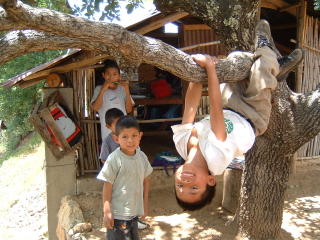( Tlah-koh-chah-WYE-yah )

Katy and I were inside the church listening to a special concert on a pipe organ that was placed here in 1735. This very rare and very fancifully carved wood and metal machine was restored in 1991 by a woman from the U.S. who lives in Oaxaca and is fanatical about saving the few pipe organ treasures left inside Mexico. A nice gift and gesture.
But the grand treasure chest itself, is the aged church and the the still vibrant, living wisdom and comfort that comes from the spirit of this place. This still survives in Mexico too, people come to restore and be restored. Some say fanatically, but still a nice gift and gesture.
This pueblo of about two thousand is named San Jeronimo Tlacochahuaya (tlah-koh-chah-WYE-yah) and is only 12 miles outside of Oaxaca city. Many of the towns in the state have this Native/Spanish Catholic saint mixture, but the locals usually drop the saints name off when referring to the town.
But in Tlacochahuaya, La Iglesia San Jeronimo is something to be proud of. That is why many of us are here for part of the week long celebration of the church's finished construction in 1586. This church was a project of the Dominican Order. They were a major player on the winning team of Spanish colonialists that came in the 1520's. The story of those ages is profound and complex, but there were a few good priests who helped restrain some of the excesses toward the indigenous people.
One good one, perhaps with a few fanatical quirks, was a Friar named Juan de Cordoba. He spent 25 years in the church without ever going out. They say he never touched money and wore only shoes to celebrate mass. But he also worked hard and wrote the first Zapotec language dictionary in 1575.
The 420 year old church has been touched up a bit with mascara/paint and construction/crutches...but the old timer still wears its age honestly. I have no photos, we are not permitted to use camera flash inside; the frescoes and artwork are delicate. And so is the atmosphere. This is not a musuem or concert hall but a functioning sacred house. While perhaps 25 concert-goers listen to Sarabanda by Handel and Gallards by Juan Cabanillas, another 60 or more townsfolk walk in and around the church listening and sometimes chatting in whispers for a connection with the statuary and painted works of St. Jerome, the Virgin of Guadalupe, and God. Very real and genuine.
Quite often Katy and I would have to shuffle aside on our wooden pew bench, along the wall of the church and underneath wooden statues that were all within reach of a hand. Zapotec families would respectfully crowd close to us, as we tilted our heads so they could touch and whisper in small tears and smiles a greeting and word of thanks and concern. Nice gesture.
These mostly Zapotec villagers of Tlacochahuaya have been here here a long time, approx. 2,500 years. The Zapotecs are the largest of the state of Oaxaca's indigenous groups..upwards of 500,000 and about one-third of the total native people.
In it's history, Mexico has had incredible shifts in the native population. Historians/Demographers estimate that Mexico had at the time of the Spanish conquest in 1519 approx. 20 million indigenous people. By the year 1600, they guess only 1 million remained after European diseases, mostly measles and smallpox, and brutal treatment. Not until 1940 did Mexico reach the same population as 1519! The state of Oaxaca will have their population reach pre-conquest levels in 2019..500 years later.
And now, many, many seasons of maize/corn later, Katy and I are here only for a short time and pleased to be a part of this town's celebration. This cycle, of restoring and being restored in Tlacochahuaya...of organs and of souls...God willing, will always be here.











